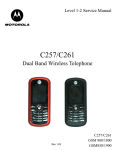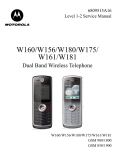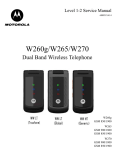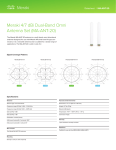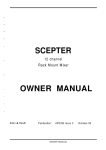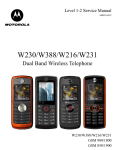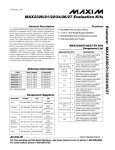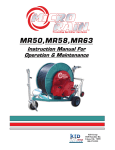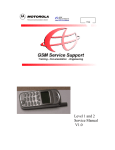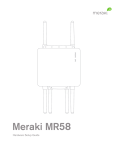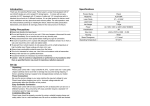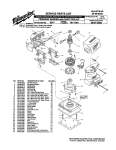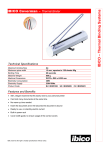Download Specifications (W370/W375)
Transcript
Level 1-2 Service Manual W370/W375 Tri-Band Wireless Telephone W370/W375 GSM 900/1800/1900 GSM850/1800/1900 Table of Contents W370/W375 Table of Contents Introduction ................................................................................................................................... 3 Product Identification ............................................................................................................ 3 Product Names ..................................................................................................................... 3 Product Changes .................................................................................................................. 3 Regulatory Agency Compliance ........................................................................................... 3 Computer Program Copyrights ............................................................................................. 4 About This Service Manual ................................................................................................... 4 Warranty Service Policy ....................................................................................................... 5 Parts Replacement ............................................................................................................... 6 Specifications (W370/W375) ......................................................................................................... 7 Product Overview .......................................................................................................................... 9 Features ............................................................................................................................... 9 General Functions ....................................................................................................................... 11 Controls, Indicators, and Input/Output (I/O) Connectors .................................................... 11 User Interface Menu Structure ........................................................................................... 13 Battery Function ................................................................................................................. 14 Operation ............................................................................................................................ 14 Tools and Test Equipment ......................................................................................................... 14 Disassembly ................................................................................................................................ 15 Removing and Replacing the Battery ................................................................................. 16 Removing and Replacing the SIM Card ............................................................................. 17 Removing and Replacing the Bottom Housing ................................................................... 17 Removing and Replacing the Spk-gasket Vibrator,rubber pad,and Speaker ..................... 20 Removing and Replacing the Main Board and Keypad ...................................................... 22 Removing and Replacing the Top Housing ........................................................................ 27 Removing and Replacing the Top Clamshell ..................................................................... 30 Removing and Replacing the Bracket,Sub-Board,VGA module,and Receiver .................. 31 Remark ............................................................................................................................... 35 Subscriber Identity Module (SIM) and Identification Label ..................................................... 37 SIM ..................................................................................................................................... 37 Identification ....................................................................................................................... 37 Troubleshooting .......................................................................................................................... 39 W370/W375 Troubleshooting Chart ................................................................................... 39 Programming: Software Upgrade and Flexing ................................................................... 40 Part Number Charts .................................................................................................................... 41 Exploded View Parts List .................................................................................................... 43 Accessories ........................................................................................................................ 45 Index ............................................................................................................................................... 1 2 Aug.15, 2006 Level 1-2 Service Manual Introduction Introduction Motorola® Inc. maintains a worldwide organization that is dedicated to provide responsive, full-service customer support. Motorola products are serviced by an international network of company-operated product care centers as well as authorized independent service firms. Available on a contract basis, Motorola Inc. offers comprehensive maintenance and installation programs that enable customers to meet requirements for reliable, continuous communications. To learn more about the wide range of Motorola service programs, contact your local Motorola products representative or the nearest Customer Service Manager. Product Identification The model number on a label (usually on the housing) identifies Motorola products. Use the entire model number when inquiring about the product. Numbers are also assigned to chassis and kits. Use these numbers when requesting information or ordering replacement parts. Product Names Product names are listed on the front cover. Product names are subject to change without notice. Some product names, as well as some frequency bands, are available only in certain markets. Product Changes When electrical, mechanical or production changes are incorporated into Motorola products, a revision letter is assigned to the chassis or kit affected, for example: -A, -B, or -C, and so on. The chassis or kit number, complete with revision number is imprinted during production. The revision letter is an integral part of the chassis or kit number and is also listed on schematic diagrams, and printed circuit board layouts. Regulatory Agency Compliance This device complies with Part 15 of the FCC Rules. Operation is subject to the following conditions: • • This device may not cause any harmful interference, and this device must accept interference received, including interference that may cause undesired operation This class B device also complies with all requirements of the Canadian InterferenceCausing Equipment Regulations (ICES-003).Cet appareil numérique de la classe B respecte toutes les exigences du Règlement sur le matériel brouilleur du Canada. Aug.15, 2006 3 Introduction W370\W375 Computer Program Copyrights The Motorola products described in this manual may include Motorola computer programs stored in semiconductor memories or other media that are copyrighted with all rights reserved worldwide to Motorola. Laws in the United States and other countries preserve for Motorola, Inc. certain exclusive rights to the copyrighted Introduction computer programs, including the exclusive right to copy, reproduce, modify, decompile, disassemble, and reverse-engineer the Motorola computer programs in any manner or form without Motorola's prior written consent. Furthermore, the purchase of Motorola products shall not be deemed to grant either directly or by implication, estoppel, or otherwise, any license or rights under the copyrights, patents, or patent applications of Motorola, except for a nonexclusive license to use the Motorola product and the Motorola computer programs with the Motorola product. About This Service Manual Using this service manual and the suggestions contained in it assures proper installation, operation, and maintenance of W370/W375 telephones. Refer questions about this manual to the nearest Customer Service Manager. This manual contains mechanical service information required for the equipment described and is current as of the printing date. Audience This document aids service personnel in testing and repairing W370/W375 telephones Service personnel should be familiar with electronic assembly, testing, and troubleshooting methods, and with the operation and use of associated test equipment. Scope This manual provides basic information relating to W370/W375 telephones, and also provides procedures and processes for repairing the units at Level 1 and 2 service centers, including: • Unit swap out • Repairing of mechanical faults • Basic modular troubleshooting • Testing and verification of unit functionality Initiate warranty claims and send faulty modules to Level 3 or 4 repair centers. 4 Aug.15, 2006 Level 1-2 Service Manual Introduction Conventions Special characters and typefaces, listed and described below, are used in this publication to emphasize certain types of information. Note: Emphasizes additional information pertinent to the subject matter. Caution: Emphasizes information about actions that may result in equipment damage. Warning: Emphasizes information about actions that may result in personal injury. M Keys to be pressed are represented graphically. For example, instead of "Press the Menu Key", you will see "Press M". Information from a screen is shown in text as similar as possible to what appears in the display. For example, ALERTS or ALERTS. Information that you need to type is printed in boldface type. Warranty Service Policy The product is sold with the standard 12-month warranty terms and conditions. Accidental damage, misuse, and extended warranties offered by retailers are not supported under warranty. Non-warranty repairs are available at agreed fixed repair prices. Out of Box Failure Policy The standard out of box failure criteria applies. Customer phones that fail very early on after the date of sale are to be returned to Manufacturing for root cause analysis, to guard against epidemic criteria. Manufacturing to bear the costs of early life failure. Product Support The customer's original phones will be repaired but not refurbished as standard. Appointed Motorola Service Hubs will perform warranty and non-warranty field service for level 2 (assemblies) and level 3 (limited Transceiver component). Motorola High Tech Centers will perform level 4 (full component) repairs. Customer Support Customer support is available through dedicated Call Centers and in-country help desks. Product-Service training should be arranged through the local Motorola Support Center. Aug.15, 2006 5 Introduction W370\W375 Parts Replacement When ordering replacement parts or equipment, include the Motorola part number and description used in the service manual. When the Motorola part number of a component is not known, use the product model number or other related major assembly along with a description of the related major assembly and of the component in question. In the U.S.A., to contact Motorola, Inc. on your TTY, call: 800-793-7834 Accessories and Aftermarket Division (AAD) Replacement parts, test equipment, and manuals can be ordered from AAD. For EMEA spare parts call +49 461 803 1638. For Asia spare parts call +65 648 62995. 6 U.S.A. Outside U.S.A. Phone: 800-422-4210 FAX: 800-622-6210 Phone: 847-538-8023 FAX: 847-576-3023 Aug.15, 2006 Level 1-2 Service Manual Specifications (W370/W375) Specifications (W370/W375) General Functions Specification Dimensions 99*45*18.6mm Weight 95g External LCD 65K color TFT, Active area 28.032 x 35.04mm, Pixel Resolution: 128(RGB)x160 Sub-LCD N/A Band "EGSM/DCS/PCS" or "GSM850//DCS/PCS" Battery 850mAh Li Ion battery Product type Clamshell Antenna Internal Frequency Range (EGSM) Tx 880-915MHz, Rx 925-960MHz Frequency Range (DCS) Tx 1710-1785MHz, Rx 1805-1880MHz Frequency Range (GSM850) Tx 824-849MHz, Rx 869-894MHz Frequency Range (PCS) Tx 1850-1910MHz, Rx 1930-1990MHz Channel Spacing 200kHz Channels 174 in EGSM, 124 in GSM859; 374 in DCS, 299 in PCS Modulation GMSK at BT=0.3 Transmitter Phase Accuracy 5 degrees RMS, 20 degrees peak Duplex spacing 45MHz EGSM/GSM850, 95MHz DCS, 80MHz PCS Frequency Stability +/- 0.1ppm of downlink frequency (RX) Operating voltage 3.53V ~ 4.2V Average Transmit Current Power Level 5: 280mA, Power Level 19: 115mA Average Standby Current DRX2: 6.5mA, DRX9: 3mA FM Radio Frequency Range 87.5-108MHz Operating Temperature -10°C to 55°C Storage Temperature -40°C to 85°C Battery Life Talking time: 4.2~8.24 hours; Standby time: 130~293 hours Battery Charge Time 240 Mins to 90% 850mAH Capacity Alert Volume Max 95dB@ 5 cm, 0.5 watts input Aug.15, 2006 7 Specifications (W370/W375) W370\W375 Transmitter Functions Specification RF Power Output EGSM/GSM850: 32.5dBm (TYP), DCS/PCS: 30dBm (TYP) Output Impedance 50 ohm (TYP) Spurious Emissions -36 dBm from 0.1 to 1GHz, -30 dBm from 1 to 4GHz Receiver Functions Specification Receiver Sensitivity EGSM/GSM850: -107dBm, DCS/PCS: -106dBm RX Bit Error Rate (100K bits) type II <2% Channel Hop Time 500 microseconds Time to Camp Approximately 6~10 Second Speech Coding Functions 8 Specification Speech Coding Type Regular pulse excitation/linear predictive coding with long term prediction (PRE LPC with LTP) Bit Rate 13.0 Kbps Frame Duration 20 ms Block Length 260 bits Classes Class 1 bits =182 bits; Class 2 bits = 78 bits Bit Rate with FEC Encoding 22.8 Kbps Aug.15, 2006 Level 1-2 Service Manual Product Overview Product Overview The Motorola W370/W375 features a global system for mobile communications wireless interface and general packet radio service (GPRS) transport technology. It also features a simplified icon and graphical user interface (UI) for easier operation in addition to short message service text messaging (SMS), speed dialing, quick dialing, an alarm, a calculator, games, and an address book. The W370/W375 is a tri-band phone that allows for roaming within the EGSM900 / DCS1800/PSC1900 or GSM850 / DCS1800/PCS1900. W370/W375 telephones support GPRS class 8 and SMS in addition to traditional circuit switched transport technologies. GPRS, where available, provides substantial increases in mobile data communications performance and the efficient use of radio spectrum. Data transmission rates for GSM networks can potentially increase from the current rate of 9.6 kbps up to a theoretical maximum of 171.2 kbps. An increased data rate is by no means the only benefit provided by GPRS. A key advantage is the provision of a permanent virtual connection to the network. This "always on" connection is possible because GPRS uses packet data transfer so that, for example, email can be downloaded in "background mode." There is no need for the user to reconnect before requesting a service, eliminating connection set-up delays and adding convenience and immediacy to data services access. The "virtual" nature of this connection means that network resources are not consumed during periods when a user is not actually sending or receiving data. The telephones are made of plastic. The display and speaker, as well as the 25- key keypad, transceiver printed circuit board (PCB), microphone, charger and headphone connectors, and power button are contained within clam shell form-factor housing. The userreplaceable 850 mAh Lithium-Ion (Li-Ion) battery provides up to 4.2-8.24 hours of talk time with up to 130293 hours of standby time. The phone accepts 1.8V/3V mini subscriber identity module (SIM) cards that fit into the SIM holder next to the battery. These telephones feature a 128 x 160 pixel color graphics display and an internal antenna. Features W370/W375 telephones use advanced, self-contained, sealed, custom integrated circuits to perform the complex functions required for GSM GPRS communication. Aside from the space and weight advantage, microcircuits enhance basic reliability, simplify maintenance, and provide a wide variety of operational functions. Features available in this family of telephones include: • • • • • • • • • • • A 128 x 160 pixel color graphics display Internal antenna Caller line identification (CLI) (Network, subscription and SIM card or service provider dependent feature. Not available in all areas.) Lower voltage technology that provides increased standby and talk times Extended GSM (EGSM) channels Tri-coder/decoder (CODEC) that allows full rate, half rate, and enhanced full rate modes of transmission Display animation VibraCall® vibrating alert 5-Way navigation key Simplified text entry using iTAP™ predictive text entry SIM Toolkit™ Class 2 (STK) (Network, subscription and SIM card or service provider dependent feature. Not available in all areas.) Aug.15, 2006 9 Product Overview W370\W375 • • • • • • Backlight Speed-, Quick- and One-Touch dialing Call Forwarding and Holding Customized Menus Personal management tools calculator with currency converter, real time clock with date, reminders, and caller profiling Other features Caller Line Identification Upon receipt of a call, the calling party's phone number is compared to the phone book. If the number matches a phone book entry, that name will be displayed. If there is no phone book entry, the incoming phone number will be displayed. In the event that no caller identification information is available, an incoming call message is displayed. Simplified Text Entry The W370/W375 features iTAP™ predictive text entry. Press a key to generate a character and a dynamic dictionary uses this to build and display a set of word or name options. The iTAP™ feature may not be available on the phone in all languages. SIM Toolkit™ - Class 2 SIM Application Toolkit is a value-added service delivery mechanism that allows GSM operators to customize the services they offer their customers, from the occasional user who requests sports news and traffic alerts, to a high call time business user who receives stock alerts and checks flight times. Operators can now create their own value-added services menu quickly and easily in the phone. The customized menu will appear as the first menu and may be updated over-the-air with new services when customers request them. Other Features Detailed descriptions of the other features can be found in the appropriate W370/W375 telephone user guides listed in the Related Publications section at the end of this manual. 10 Aug.15, 2006 Level 1-2 Service Manual General Functions General Functions Controls, Indicators, and Input/Output (I/O) Connectors The W370/W375 phone's controls are located on the front side of the device and on the keyboard as shown in below. Indicators icons are displayed on the LCD. Earpiece Menu Key Listen to your voice calls & messages. Open a menu when it appears in the display. Right Soft Key Left Soft Key Perform functions identified by Perform functions identified right display prompt. by left display prompt. Web Browser Key Message Key Access the Message menu. Volume Controls Send/Answer Key Make & answer calls. Press in idle screen to see the recently dialed calls. Mini-USB Connector Change the battery or connect to a PC. Power/End Key Press & hold to turn the phone on/off. Press & release to end phone calls, exit menu system. Navigation Key Scroll up, down, left or right. Headset Jack Battery Indicator Message Indicator Call Indicator Camera Lens Battery Headset Jack Insert the headset accessory for handsfree use. Figure 1. Phone Controls Menu Navigation W370/W375 telephones are equipped with a simplified icon and graphical-based user interface. See the table below for details of the W370/W375 menu structure. A five-way navigation key allows you to move easily through menus and confirm your selection. Aug.15, 2006 11 General Functions W370\W375 Liquid Crystal Display (LCD) The LCD provides a multicolor backlit color display with user-adjustable contrast settings for optimum readability in all light conditions. The bit-map 128 x 160 pixel display includes up to 3 lines of text, 1 line of icons, and 1 line of prompts. Home Screen Display Clock Left Soft Key Label Icon Name Signal Strength Menu indicator Right Soft Key Label Description Vertical bars show the strength of the network connection. GPRS Service Available Indication If user is at a GPRS service available area. Data Connection Status if user choses CSD bear type as data connection bear. If user choses GPRS bear type as data connection bear. If user activates GPRS service. Security Link If the browser link is a security web site. Roam If data is transmitting over GPRS connection. If data is transmitted finishedly over GPRS connection. If user roam to another network. On Call If a phone call is connected. Data Transmition The activate line is line1. The activate line is line2. Line1 is set as call forward. Line2 is set as call forward. New chat message. Activate Line Call Forward New Voice Mail received. Message Indicator New Voice Mail and Message received. New Text/MMS/WAP Push message received. Message Full Alert Indicator RingStyle set as LoudRing. RingStyle set as SoftRing. RingStyle set as Vibrate. RingStyle set as Vibrate And Ring. RingStyle set as VibrateThenRing. RingStyle set as Silent. Battery level Indicator Vertical bar shows the battery level. Headset Indicator Shows the phone is connecting with headset. Figure 2. LCD Icons 12 Aug.15, 2006 Level 1-2 Service Manual General Functions User Interface Menu Structure The table below shows a portion of the W370/W375 telephone menu structure. Menu Map n Phonebook s Recent Calls á Web Access • • • • • • • Received calls Dialed Calls NotePad Call Times Call Cost Date Times Date Volumes e Messages • Create • Inbox • Draft • Outbox • Quick Notes • Voicemail • Browser Msgs • Info Services • MMS Templates É Office Tools • Calculator • MyMenu • Alarm Clock • Stop Watch • Chat • Dialing Services • STK Service • Calendar • Lantern Q Games & Apps • Football • Space • Crazy • Sound Settings • • • • • • • Start Browser Web Shortcut Go to URL Web Session Stored Pages History General Setting h Multimedia • Camera • Pictures • Sounds • FM Radio l Personalize • Home Screen • Main Menu • Color Setting • Greeting • Wallpaper • Screen Saver • Quick Dial w Settings • Ring Style • Call Forward • In Call Setup • Initial Setup • Phone Status • Headset • Network • Security • Easy Prefix • Lantern Note: The STK Service depends on your carrier’s SIM card. You may not see this function. Chat, Quick Dial and Easy Prefix depend on your carrier’s settings.. You may not see these features in your phone. Figure 3. Telephone Menu Structure Aug.15, 2006 13 Tools and Test Equipment W370\W375 Battery Function The telephone displays a battery charge indicator icon in the idle screen to indicate the battery charge level. The gauge shows four levels: 100%, 66%, 33%, and Low Battery. Removing the battery causes the phone to shut down immediately and loose any pending work (partially entered phone book entries or outgoing messages, for example). Note: All batteries can cause property damage and/or bodily injury such as burns if a conductive material such as jewelry, keys, or beaded chains touches exposed terminals. The conductive material may complete an electrical circuit (short circuit) and become quite hot. Exercise care in handling any charged battery, particularly when placing it inside a pocket, purse, or other container with metal objects. If the battery is removed while receiving a message, the message is lost. To ensure proper memory retention, turn the phone OFF before removing the battery. Immediately replace the old battery with a fresh battery. Operation For detailed operating instructions, refer to the appropriate User Guide listed in the Related Publications section toward the end of this manual. Tools and Test Equipment The table below lists the tools and test equipment used on W370/W375 telephones. Use either the listed items or the equivalent. Table 1: General Test Equipment and Tools Motorola Part Number1 Application See Table 6 Charger Used to charge battery and power phone 0180386A82 Antistatic Mat Kit (includes 66-80387A95 antistatic mat, 66-80334B36 ground cord, and 42-80385A59 wrist band) Provides protection from damage to phone caused by electrostatic discharge (ESD) Antistatic Gloves Provides protection from damage to phone caused by electrostatic discharge (ESD) 8102430Z04 GSM / DCS / PCS Test SIM Used to enable manual test mode 6680388B67 Disassembly tool, plastic with flat and pointed ends (manual opening tool) Used during assembly/disassembly 6680388B01 Tweezers, plastic Used during assembly/disassembly - T5 screw driver Used with screw driver - camera jig Used to remove a built-in camera (where present) - 14 Description Aug.15, 2006 Level 1-2 Service Manual Disassembly Table 1: General Test Equipment and Tools Motorola Part Number1 HP34401A2 Description Digital Multimeter Application Used to measure battery voltage 1. To order in North America, contact Motorola Aftermarket and Accessories Division (AAD) by phone at (800) 422-4210 or FAX (800) 622-6210. Internationally, AAD can be reached by calling (847) 538-8023 or by fax (847) 576-3023. 2. Not available from Motorola. To order, contact Hewlett Packard at (800) 452-4844. Figure 4. A screwdriver (T5), a pair of tweezers, and a camera jig Note: This particular camera requires a unique camera jig (pictured on the far right) for disassembly of the camera, where present. You can order this tool from Motorola using the information presented above in Footnote 1. Disassembly Many of the integrated devices used in this phone are vulnerable to damage from electrostatic discharge (ESD). Ensure adequate static protection is in place when handling, shipping, and servicing any internal components. Avoid stressing the plastic in any way to avoid damage to either the plastic or internal components. Aug.15, 2006 15 Disassembly W370\W375 Removing and Replacing the Battery All batteries can cause property damage and/or bodily injury such as burns if a conductive material such as jewelry, keys, or beaded chains touches exposed terminals. The conductive material may complete an electrical circuit (short circuit) and become quite hot. Exercise carein handling any charged battery, particularly when placing it inside a pocket, purse, or other container with metal objects. 1. 2. Ensure the phone is turned off. Press the battery cover release button and then slide it away. Figure 5. Opening the battery cover 3. Next, push the battery inward, and as it disengages pull it up and away from the battery compartment. Figure 6. Removing the battery 16 Aug.15, 2006 Level 1-2 Service Manual Disassembly There is a danger of explosion if the Lithium ion battery is replaced incorrectly. Replace only with the same type of battery or equivalent as recommended by the battery manufacturer.Dispose of used batteries according to the manufacturer's instructions. Removing and Replacing the SIM Card 1. 2. Remove the battery, as described earlier. Remove the SIM from its holder by sliding it in the direction shown below. Figure 7. Removing the SIM Card 3. 4. To replace, carefully slide the SIM into position in its socket. The latch secures the SIM when correctly positioned over the terminals in the phone. Replace the battery. Removing and Replacing the Bottom Housing 1. 2. Remove the SIM as described earlier. Remove the cap. Figure 8. Removing the cap Aug.15, 2006 17 Disassembly W370\W375 3. Remove the two T5 screws. (Use torque force of 10.78 Ncm). Figure 9. Removing the screws 4. Remove the four T5 screws. (Use torque force of 10.78 Ncm) . (Figure 10. Removing the screws 18 Aug.15, 2006 Level 1-2 Service Manual Disassembly 5. Push housing to separate the latch. Latch Figure 11. Disengaging the latches 6. Use one hand to grip the case firmly and pry it apart a fraction, then disengage 2 latches connecting it to the front housing. Figure 12. Disengaging the latches Aug.15, 2006 19 Disassembly W370\W375 7. Pry the back housing away from the front. Figure 13. Separating the back housing Removing and Replacing the Spk-gasket Vibrator,rubber pad,and Speaker 1. 2. Remove the bottom housing as described earlier. Remove the spk-gasket. Figure 14. Removing the Spk-gasket 20 Aug.15, 2006 Level 1-2 Service Manual Disassembly 3. Remove the vibrator. Figure 15. Removing the vibrator 4. Remove the two rubber pad. Figure 16. Removing the rubber pad Aug.15, 2006 21 Disassembly W370\W375 5. Insert a thin screwdriver or tweezers beneath the speaker chip, then gently pry it out. Figure 17. Removing the speaker chip Removing and Replacing the Main Board and Keypad 1. 2. 3. Remove the bottom housing as described earlier. Use hand tooling pry out the conduct. Need to replacing new conduct P/N#306AH80001W after repair process. Figure 18. Removing the conduct 22 Aug.15, 2006 Level 1-2 Service Manual Disassembly 4. Remove the side rubber. Figure 19. Removing the side rubber 5. Pry off the FPC connector. Figure 20. Prying off the FPC connector Aug.15, 2006 23 Disassembly W370\W375 6. Remove the main board. Figure 21. Remove the main board 7. Push two clip to pry off the antenna. Figure 22. Prying the antenna 24 Aug.15, 2006 Level 1-2 Service Manual Disassembly 8. Pry off the microphone. Figure 23. Prying the microphone 9. Pry off the spring, carefully when Removing and replacing spring. Figure 24. Prying the spring Aug.15, 2006 25 Disassembly W370\W375 10. Remove the keypad. Figure 25. Removing the keypad 11. Remove the lanyard. Figure 26. Removing the lanyard 26 Aug.15, 2006 Level 1-2 Service Manual Disassembly Removing and Replacing the Top Housing 1. 2. Remove the main board and keypad as described earlier. Use hand tooling remove four rubber cover. Figure 27. Remove four rubber cover 3. Remove four T5 screws. (Use torque force of 10.78 Ncm) Figure 28. Removing the four T5 screws Aug.15, 2006 27 Disassembly W370\W375 4. With a flat pry bar, disconnect the two halves. Figure 29. Disconnecting the two halves 5. Disconnect the two halves (they are joined by a total of 7 latches). Figure 30. Separate the top housing 28 Aug.15, 2006 Level 1-2 Service Manual Disassembly 6. Remove the rubber. Figure 31. Removing the rubber 7. Use hand tooling remove the HINGE-KB. Be sure you don't inadvertently damage the FPC. Figure 32. Removing the rubber Aug.15, 2006 29 Disassembly W370\W375 Removing and Replacing the Top Clamshell 1. 2. Remove the Top Housing as described earlier. Insert a hook into the left hinge space, press down, and then exert pressure by pressing the clamshell forward. Figure 33. Exerting pressure on the clamshell 3. Gently disconnect the top clamshell, being careful to not snag or damage the FPC as it slips out of the notch that protects it. Figure 34. Disconnecting the top clamshell 30 Aug.15, 2006 Level 1-2 Service Manual Disassembly Removing and Replacing the Bracket,Sub-Board,VGA module,and Receiver 1. 2. 3. Remove the top clamshell as described earlier. Remove the conduct. Need to replacing new conduct P/N#306AH80001W after repair process. Figure 35. Removing the conduct 4. Pry off the FPC connector. Figure 36. Prying off the FPC connector Aug.15, 2006 31 Disassembly W370\W375 5. Disengaging the three latches. Figure 37. Disengaging the latches 6. Disengaging the three latches. Figure 38. Separating the bracket 32 Aug.15, 2006 Level 1-2 Service Manual Disassembly 7. Pry off the Sub-board. Figure 39. Removing the sub-board 8. Pry off the VGA FPC connector and remove VGA module. Figure 40. Prying off the VGA module Aug.15, 2006 33 Disassembly W370\W375 9. Pop out the receiver. If you remove a functioning receiver, you will irreparably damage it and must therefore replace it. Figure 41. Removing the receiver 34 Aug.15, 2006 Level 1-2 Service Manual Disassembly Remark 1. In the event the SIM Card warps after being inserted. (shown as Figure 42 below) Figure 42. 2. Solution : The angle of insertion must be lower than the surface of the Shielding Can, when the factory disassembles the Shielding Can to rework. (shown in the following figure) the surface of Shielding Can This shear plane must be lower than that of Shielding Can. OK NG Figure 43. Aug.15, 2006 35 Disassembly W370\W375 3.1 Cover the shielding case(P/N:3052H80005W) as the figure 44. Figure 44. 3.2 Stick the black mylar(P/N:3064H80001W) on the surface of shielding case as the figure 45. Figure 45. 36 Aug.15, 2006 Level 1-2 Service Manual Subscriber Identity Module (SIM) and Identification Label Subscriber Identity Module (SIM) and Identification Label SIM A SIM is required to access the existing local GSM network, or remote networks when traveling (if a roaming agreement has been made with the provider). The SIM contains: • • • All the data necessary to access GSM services The ability to store user information such as phone numbers All information required by the network provider to provide access to the network Identification Each Motorola GSM phone is labeled with a variety of identifying numbers. The following information describes the current identifying labels. Mechanical Serial Number (MSN) • • • The MSN is an individual unit identity number and remains with the unit throughout its life. The MSN can be used to log and track a phone on Motorola's Service Center Database. The MSN is divided into 4 sections as shown in Figure 46. MSN 10 Digits 3 Digits 1 Digit 2 Digits 4 Digits APC DC DC SNR Account Product Code i.e. StarTAC™ Phone130 Distribution Center i.e. Easter Inch Date Code: Year and Month of Shipment Unit's individual serial number Figure 46. MSN Divisions International Mobile Station Equipment Identity (IMEI) The International Mobile Station Equipment Identity (IMEI number is an individual number unique to the Transceiver and is stored within the unit's memory. The IMEI uniquely identifies an individual mobile station and thereby provides a means for controlling access to GSM networks based on mobile station types or individual units. The full IMEI structure is listed in the table below. Aug.15, 2006 37 Subscriber Identity Module (SIM) and Identification Label W370\W375 Table 2: IMEI Number Breakdown TAC NNXXXXXX Serial Number ZZZZZZ Check Digit A Where TAC Type Allocation Code, formerly known as Type Approval Code NN Reporting Body Identifier (BABT or CTIA) XXXXXX Type Identifier (defined by BABT or CTIA) ZZZZZZ Individual unit serial number A Phase 1 = 0. Phase 2 & 2+= check digit and is defined as a function of all other IMEI digits Other label number configurations present are: • • 38 TRANSCEIVER NUMBER: Identifies the product type. Normally the SWF number. (i.e. V100). PACKAGE NUMBER: Identifies the equipment type, mode, and language in which the product is shipped. Aug.15, 2006 Level 1-2 Service Manual Troubleshooting Troubleshooting W370/W375 Troubleshooting Chart Level 1 and 2 Troubleshooting Chart Symptom 1. Phone will not turn on or stay on. Probable Cause Verification and Remedy a) Battery either discharged or defective. Measure battery voltage across a 50 ohm (>1 Watt) load. If the battery voltage is <3.25 Vdc, recharge the battery using the appropriate battery charger. If the battery will not recharge, replace the battery. If battery is not at fault, proceed to b. b) Battery terminals open or misaligned. Visually inspect the battery terminals on both the battery and the phone. Realign and, if necessary, either replace battery or refer to a Level 3 Service Center for the battery connector replacement. If battery terminals are not at fault, proceed to c. c) Keypad defective. Replace the keypad. Temporarily connect a +3.6 Vdc supply to the battery terminals. Press and hold the PWR button. If phone turns on and stays on, disconnect the dc power source and reassemble with the new keypad. 2. Phone exhibits poor reception or erratic operation such as calls frequently dropping or weak or distorted audio. Connections to or from lower PCB defective. Check connection between the antenna and the lower PCB. 3. Display is erratic, or provides partial or no display. LCM defective. Replace the LCM. Verify that the fault has been cleared and reassemble the phone with the new LCM. 4. Incoming call alert transducer audio distorted or volume is too low. Speaker defective. Replace the speaker as described in the procedures. Verify that the fault has been cleared and reassemble the phone with the new speaker. 5. Phone transmit audio is weak. (usually indicated by called parties complaining of difficulty in hearing voice). Microphone defective. Replace the microphone as described in the procedures. Verify that the fault has been cleared and reassemble the phone with the new microphone. 6. Receive audio from earpiece speaker is weak or distorted. a) Connections to or from lower PCB defective. Check connection between the antenna and the lower PCB. If the connection is OK, proceed to b. b) Earpiece Speaker defective. Temporarily replace the earpiece speaker with a known good earpiece speaker. Ensure good connection. Place a call and verify improvement in earpiece audio. If fault is cleared, reassemble the phone with the good earpiece speaker. Aug.15, 2006 39 Troubleshooting W370\W375 Level 1 and 2 Troubleshooting Chart (Continue) Symptom Probable Cause Verification and Remedy 7. Phone will not recognize or accept SIM card. SIM card defective. Check the SIM card contacts for dirt. Clean if necessary, and check if fault has been cleared. If the contacts are clean, insert a known good SIM card into the phone. Power up the phone and confirm that the card has been accepted. If the fault no longer exists, replace the defective SIM card. 8. Keypad not functioning. Keypad defective. Use alcohol to wipe the keypad metal dome. Check if fault has been cleared. If the fault is still present, either replace the keypad or refer to a Level 3 Service Center for the keypad metal dome replacement. 9. Vibrator feature not functioning. a) Vibrator faulty. Check general condition of vibrator. If it is good, proceed to b. b) Vibrator defective. Replace the defective vibrator. a) Headset plug not fully pushed. Ensure the headset plug is fully seated in the jack. If the seated is OK, proceed to b. b) Headset defective. Temporarily replace the headset with a known good headset. Ensure good seated. Place a call and verify improvement in headset audio. If fault is cleared, replace the defective headset. Camera module defective. Replace the camera module as described in the procedures. Verify that the fault has been cleared and reassemble the phone with the new camera module. 10. No or weak audio when using headset. 11. Camera module not functioning. (for W375) Programming: Software Upgrade and Flexing Contact your local technical support engineer for information about equipment and procedures for flashing and flexing. 40 Aug.15, 2006 Level 1-2 Service Manual Part Number Charts Part Number Charts Figure 47. W375 Exploded View Diagram Aug.15, 2006 41 Part Number Charts W370\W375 Figure 48. W370 Exploded View Diagram 42 Aug.15, 2006 Level 1-2 Service Manual Part Number Charts Exploded View Parts List Table 3: W375 Exploded View Parts List Item Number 001 002 003 004 005 006 051 251 252 253 300 301 302 303 304 305 306 307 308 309 310 311 312 313 314 315 316 317 318 319 320 321 322 323 324 325 326 327 328 329 332 350 351 352 Part Number 2220601101W 2240071102W 3930407501W G 7630001895W 2250160807W 7651H90001W 82E5803301W G 6910890001W G 6320500001W G 21H80030C1W 5501350001W G 254JH80001W 2526H80001W 3023H80001W 2551H80001W 2538H80001W 3106H80001W 3101H80001W 3041H80001W 23A1H80001W 3109H80001W 3064H80001W 3052H80001W 302FH80001W 303LH80002W 302BH80002W 302BH80001W 2527H80001W 3028H80001W 254AH80001W 2517H80001W 303LH80003W 303LH80001W 305AH80001W 302AH80001W 302AH80003W 302AH80002W 2516H80001W 3407119001W 2541H80001W 302BH80007W 3501745101W 3501733103W 254CH80001W Description MIC RECEIVER SPR-VIB LCM SPEAKER CAMERA LABEL F/WMB 33 SMT LCM/B PCB-ASSY ME/PT 33 COVER KB UPP-C MIC-HOLD LANYARD HINGE-KB VOL-KEY DIAL-KEY SPRING ANT-ASSY MET-DOME MYLAR SHIELD-C SPK-GASKE BTB-SPON RUBBERPAD RUBBERPAD KB LOW-C RF-COV LED-LENS DISLOWASY BTB-SPON BTB-SPON BRACKET RUBBER RUBBER RUBBER DISUPPASY HINGE LCD-LENS RUBBERPAD SCREW SCREW SCREW-COV Specification ACM6011-02P22-413ψ 6*1.1 AAC SDRP0711KJ01-F1-G 32ohm 7*11mm ψ4*L7.55 1.3V LA4-458DB COPAL TD018THEJ8 128*160 TOPPOLY DMS1608F-05-PC-FB-G 8ohm AAC H90 CM-5628 VGA CHICONY E58 WATERPROOF LABEL φ 4mm H80 GA-114 H80/H80A GS-063 H80 GF-057 REV:0C FB H80 SILVER H80-PC-SILVER H80-IXEF1622-BLACK H80-RUBBER-BLACK H80-PC-BLACK H80-PC-BLACK H80-RUBBER-SILVER-1 H80-RUBBER-BLACK-23 H80-C1720-4.8*12.3*0.2-KB H80-EU TRI BAND H80-ψ4*170g-23 H80-12.8*13.5*0.15 H80-SUS304-40.2*34.2*1.50 MCOV H80-RUBBER-39*18.4*4.7 H80-PORON-6.2*8.8*1-KB H80-TPU-SILVER-AUDIO H80-TPU-SILVER-USB H80-PC-SILVER H80-RUBBER-SILVER H80-MR58-BLACK H80-SILVER H80-PORON-4*12*0.3-CAMERA H80-PORON-7.5*11*0.3-DIS H80-SUS304-39*62.9*0.3 H80-8.6*9.4*4.3-VGA COVER H80-RUBBER-TRANSPARENT-LED H80-10.7*7.9*4.2-VGA BASE H80-BLACK H96-FE+AU-F7*11.95-5 PREXCO H80-MR58-TRANSPARENT H80-SILICON-6*7-WHITE-HINGE TORX M1.7*4.5-BLACK-NI KL-IXEF TORX M1.7*3.3-BLACK-NI KL H80-RUBBER-BLACK Aug.15, 2006 43 Part Number Charts W370\W375 Table 4: W370 Exploded View Parts List Item Number 001 002 003 004 005 051 251 252 253 300 301 302 303 304 305 306 307 308 309 310 311 312 313 314 315 316 317 318 319 320 322 323 325 327 328 329 332 350 351 352 44 Part Number 2220601101W 2240071102W 3930407501W 7630001895W 2250160807W 82E5803301W 6910890011W 6320500011W 21H80030C1W 5501430001W 254JH80001W 2526H80001W 3023H80001W 2551H80001W 2538H80001W 3106H80001W 3101H80001W 3041H80001W 23A1H80A01W 3109H80001W 3064H80001W 3052H80001W 302FH80001W 303LH80002W 302BH80002W 302BH80001W 2527H80001W 3028H80001W 254AH82A01W 2517H80001W 303LH80001W 305AH80001W 302AH80003W 2516H80001W 3407119001W 2541H80001W 302BH80007W 3501745101W 3501733103W 254CH80001W Description MIC RECEIVER SPR-VIB LCM SPEAKER LABEL F/WMB 33 SMT LCM/B PCB-ASSY ME/PT 33 COVER KB UPP-C MIC-HOLD LANYARD HINGE-KB VOL-KEY DIAL-KEY SPRING ANT-ASSY MET-DOME MYLAR SHIELD-C SPK-GASKE BTB-SPON RUBBERPAD RUBBERPAD KB LOW-C RF-COV LED-LENS DISLOWASY BTB-SPON BRACKET RUBBER DISUPPASY HINGE LCD-LENS RUBBERPAD SCREW SCREW SCREW-COV Specification ACM6011-02P22-413 ψ6*1.1 AAC SDRP0711KJ01-F1-G 32ohm 7*11mm ψ4*L7.55 1.3V LA4-458DB COPAL TD018THEJ8 128*160 TOPPOLY DMS1608F-05-PC-FB-G 8ohm AAC E58 WATERPROOF LABEL φ4mm H80A GA-114 H82A GS-063 H80 GF-057 REV:0C FB H82A SILVER H80-PC-SILVER H80-IXEF1622-BLACK H80-RUBBER-BLACK H80-PC-BLACK H80-PC-BLACK H80-RUBBER-SILVER-1 H80-RUBBER-BLACK-23 H80-C1720-4.8*12.3*0.2-KB H80A-US TRI BAND H80-ψ4*170g-23 H80-12.8*13.5*0.15 H80-SUS304-40.2*34.2*1.50 MCOV H80-RUBBER-39*18.4*4.7 H80-PORON-6.2*8.8*1-KB H80-TPU-SILVER-AUDIO H80-TPU-SILVER-USB H80-PC-SILVER H80-RUBBER-SILVER H82A-MR58-BLACK H80-SILVER H80-PORON-7.5*11*0.3-DIS H80-SUS304-39*62.9*0.3 H80-RUBBER-TRANSPARENT-LED H80-BLACK H96-FE+AU-F7*11.95-5 PREXCO H80-MR58-TRANSPARENT H80-SILICON-6*7-WHITE-HINGE TORX M1.7*4.5-BLACK-NI KL-IXEF TORX M1.7*3.3-BLACK-NI KL H80-RUBBER-BLACK Aug.15, 2006 Level 1-2 Service Manual Part Number Charts There is a danger of explosion if the Lithium ion battery pack is replaced incorrectly. Replace only with the same type of battery or equivalent as recommended by the battery manufacturer. Dispose of used batteries according to the manufacturer's instructions. To order parts please use the following Link: https://servicelink3.motorola.com (Password is required) For information on ordering parts please contact EMEA at +49 461 803 1638. Accessories Table 5: List of Accessories Description Power Solutions BQ50 battery 850 mAh BT50 battery 850 mAh EMU Switch Mode Midrate (PRC) EMU Switch Mode Midrate (US) EMU Switch Mode Midrate (Taiwan) EMU Switch Mode Midrate (Euro) EMU Switch Mode Midrate (HK/UK) EMU Switch Mode Midrate (Australia) EMU Switch Mode Midrate (India) EMU Switch Mode Midrate (Mexico) EMU Switch Mode Midrate (Brazil) EMU Switch Mode Midrate (Arg) EMU Switch Mode Dual Rate (Brazil) EMU Switch Mode Dual Rate (Arg) EMU Switch Mode Dual Rate (PRC) EMU Switch Mode Dual Rate (HK) EMU Switch Mode Dual Rate (Mex) EMU Switch Mode Dual Rate (US) EMU Switch Mode Dual Rate (Twn) Part Number SNN5804A SNN5771A SPN5188B SPN5185B SPN5216C SPN5189B SPN5190B SPN5193B SPN5194B SPN5186B SPN5187B SPN5192B SPN5196B SPN5197B SPN5198B SPN5199B SPN5200B SPN5202B SPN5270B In-Vehicle VC700 EMU Power Adapter SYN0847A Audio&Connectivity Mini USB/USB/Serial Data Cable Mono Earbud Headset (Black) Mono Earbud Headset (Silver) One-Touch Headset Stereo One-Touch Earbud Headset Stereo One-Touch Earbud Headset Right-Angle Adapter Audio Converter SKN6371B/C SYN8390B AAYN4264B SYN8419C CHYN4516B SYN1603B SKN6182A SKN6183A Consumer&Personalization Silver Lanyard (Asia except PRC) Silver Lanyard AAYN4402A CHYN4546 Aug.15, 2006 45 Part Number Charts 46 W370\W375 Aug.15, 2006 Level 1-2 Service Manual Index Index A About Audience 4 Conventions 5 Scope 4 Accessories and Aftermarket Division 6 Audience 4 B Battery Function 14 Operation 14 Battery Gauge 14 C Caller Line Identification 10 Controls 11 Conventions 5 Customer Support 5 D Disassembly 15 E Electrostatic Discharge 15 G General Functions 11 H Headset Connector Port 11 I Indicators 11 Input/Output (I/O) Connectors 11 International Mobile Station Equipment Identity (IMEI) 37 Number Breakdown 37 Aug.15, 2006 Index-1 Level 1-2 Service Manual Index L Left Soft Key 11 Liquid Crystal Display (LCD) 12 Low Battery 14 M Mechanical Serial Number 37 Menu Key 11 Menu Navigation 11 Microphone 11 N Navigation Key 11 O Other Features 10 Out of Box Failure Policy 5 P Part Number Charts 41 Parts Replacement 6 Accessories and Aftermarket Division 6 Power Connector Port 11 Power/End Key 11 Product Overview 9 Caller Line Identification 10 Features 9 Other Features 10 SIM Toolkit™ - Class 2 10 Simplified Text Entry 10 Product Support 5 R Right Soft Key 11 S Scope 4 Send/Answer Key 11 SIM Card 37 Identification Label 37 International Mobile Station Equipment Identity (IMEI) 37 Mechanical Serial Number 37 SIM Toolkit™ - Class 2 10 Simplified Text Entry 10 Specifications 7 Aug.15, 2006 Index-2 Level 1-2 Service Manual Index T Tools and Test Equipment 14 Troubleshooting 39 U USB Connector Port 11 User Interface 11 User Interface Menu Structure 13 W Warranty Service Policy 5 Customer Support 5 Out of Box Failure Policy 5 Product Support 5 Aug.15, 2006 Index-3 Level 1-2 Service Manual Index Aug.15, 2006 Index-4 MOTOROLA, the Stylized M Logo, and all other trademarks indicated as such herein are trademarks of Motorola, Inc. All other product or service names are the property of their respective owners. ® Reg. U.S. Pat. & Tm. Off. © 2005 Motorola, Inc. All rights reserved. Personal Communications Sector, Sawgrass International Concourse 789 International Parkway Room S2C Sunrise, FL 33323



















































